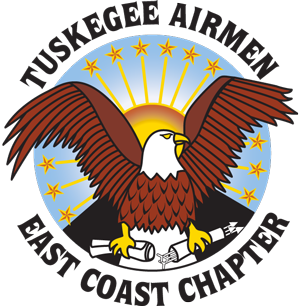| EAST COAST CHAPTER |
NEGRO FLYING UNITS
99th Fighter Squadron initially comprised of 272 enlisted men and five cadets, was activated at Chanute Technical Training Center, Chanute Field, Illinois, on March 22, 1941, under the command of two White officers. Captain Harold R. Maddux, and Second Lt. Clyde H. Bynum, assigned temporarily in a supervisory capacity. Upon completion of their training on November 5, 1941, the squadron moved to Maxwell Field, Alabama, where they remained for several days before proceeding to nearby Tuskegee Army Air Base (TAAF) on November 10, 1941. At this time, Captain Maddux and Lt. Bynum returned to their stations at Chanute Field.
TAAF had been activated in July 1941, and the first aviation cadets accepted for flight training. The first class of five Negro flying officers was graduated on March 7, 1942 and transferred to the 99th Fighter Squadron and became the first members of the air echelon of the unit. Subsequent graduates were added to complete to pilot complement for the squadron by November 10, 1942. The squadron with its Air Force Service Detachment 99, embarked for their over-seas assignment in April 1943.
332nd Fighter Group, was activated October 18, 1942 and assigned to the Third Air Force. Their station of activity was Tuskegee Army Flying School, Tuskegee, Alabama. The Group was comprised of the following units:
- 332nd Fighter Group Headquarters – October 18, 1932
- Fighter Control Squadron – October 18, 1942
- 100th Fighter Squadron – May 23, 1942, TAAF, Reassigned July 9, 1942
- 301st Fighter Squadron – October 13, 1942
- 302nd Fighter Squadron – October 13, 1942
- 99nd Fighter Squadron – Reassigned July 1944
- 524th Air Service Group Headquarters – March 24, 1945, Ramitelli, Italy & Base Service Squadron
- 524th Air Service Group – March 24, 1945, Jesi, Italy & Base Service Squadron
- 950th Air Engineering Squadron – March 24, 1945, Falconara, Italy
- 744th Air Material Squadron – March 24th 1945, Jesi, Italy
- 477th Bombardment Group (Medium) (Colored), activation effective January 15, 1944, Selfridge Field, Michigan
- 616th Bombardment Squadron – January 15, 1944
- 617th Bombardment Squadron – April 15, 1944
- 618th Bombardment Squadron – May 15, 1944
- 619th Bombardment Squadron – June 15, 1944
- 387th Air Service Group Headquarters – 1945, Godman Field, Kentucky & Base Service Squadron
- 602nd Engineering Squadron – 1945, Godman Field, Kentucky
- 590th Air Service Squadron – March 24, 1945, Godman Field, Kentucky
- 773rd Air Material Headquarters – March 24, 1945, Godman Field,Squadron, Kentucky
- 118th Army Air Force Base Unit (Documentation not located)
- 776th Army Air Force Band (Documentation not located)
- 1078th Ordnance Company (Aviation) (Documentation not located)
- 477th Headquarters, reassigned to Lockbourne Army Air Base
- 118th Army Air Force Base Unit
- 318th Army Air Force Base Unit
- 477th Composite Group, activated at Lockbourne Air Force Base
- 580th Air Service Group Headquarters & Base Service Squadron
- 602nd Air Engineering Squadron
- 1062nd Air Materials Squadron
- 4413th Woman's Air Force Squadron, activated at Lockbourne Air Force Base
332nd Fighter Wing, established July 28, 1947. Lockbourne Air Force Base. At the same time a 332nd Air Service Group was also established, both units under the command of Colonel Benjamin O. Davis, Jr. The Wing replaced the 477th Composite Group. The 580th participated in firepower demonstrations and gunnery training to maintain proficiency during 1948-49. Four 332nd Wing pilots, flying P-47's in the Air Force-wide Top Gun demonstrations in Las Vegas in May 1949 came away with first place honors. The Wing was inactivated on July I, 1949.
All the above superbly trained, non-flying Negro support units achieved outstanding success in combat abroad and in readiness training at home, and have reflected great credit upon themselves and glory on the armed services in which they served. They were a source of pride and amply justified the faith that the Negro community had in their potential as they first ventured into this new and exciting field of modern technological warfare during World War II. Nevertheless while Negro America thrilled to the feats of our fighter-pilots, scores of officers and enlisted men associated with the air echelon who never share the glory but who labor uncomplainingly night and day to "keep them flying and bring them back alive. The following poem "Ground Crews" intones these sentiments:
We're just the boys of echelon, who don't wear silver wings;
We only keep them flying, and take the grief that brings.
We get no glaring headlines, and we hear no songs of praise.
And when we sign the job as done, our necks stick out always.
Electricians, fitters, riggers, with instruments and guns,
We take the crate to pieces to see just how it runs.
So, aircrews keep them flying and when you score a victory
We'll be the first to cheer.By LAC Wharton May, 1943, RCAF
As the poem suggests, line mechanics, ground service and technical support and administrative units seldom are the focus of attention and publicity, but without them no tactical or strategic mission directed against the enemy, would get off the ground. Even more, the quality of their maintenance was often the margin of difference between the life and death of an aircrew or the success or failure of a mission and as such, were equally courageous pioneers of the air wars as the more glamorous pilots who largely eclipsed them.
EAST COAST CHAPTER National Harbor, MD 20745
|
